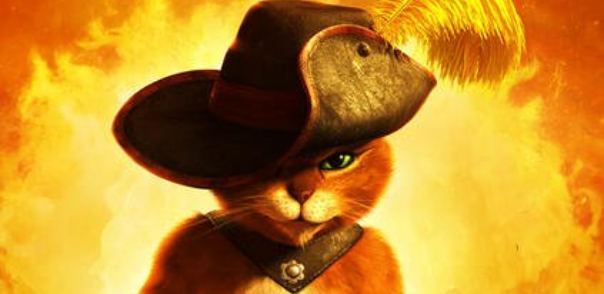Puss gets his own film, but can't carry it.

I was initially interested in Puss in Boots because of my love for the Shrek franchise (or at least the first two films), but the trailer looked pretty painful. Sadly, the trailer does the film justice. Its art and animation are its only strengths.
Puss teams up with former partner Humpty Dumpty and the seductive Kitty Softpaws to steal magic beans, grow a beanstalk, ride the beanstalk up to the castle in the clouds and steal some golden eggs, making them forever rich. Along the way they encounter adventure, revenge and romance as well as a host of marauding outlaws, vicious beasts and an angry monster.
As I was watching, it became apparent that Puss in Boots hoped to ride Shrek’s success and launch a brand new franchise. But Puss lacks any of the charm that made the first Shrek movies so delightful. Gone are the witty cynicisms, the backhanded slams of fairy tale characters and conventions. Gone are the hilarious pop culture references and the sarcastic one-liners. Instead, all that’s left are weak attempts at humor consisting of potty jokes and a few puns that try to support a film mostly devoid of laughs.
To its credit, there were a few solid moments of genuine comedy. The filmmakers did their research on feline behavior, which they exaggerated in hilarious fashion. Anyone with a cat will appreciate as Puss chases light reflections, performs a litter box dance, and brings a dead bird to his human “mother” as a present. These gags worked while others fell flat, often reverting to tasteless bathroom humor and innuendo. An early scene takes place in “Dance Club” (an attempt to spoof “Fight Club”), where Puss and Kitty dance to the death. The scene is long, cheesy and unnecessary, failing to satirize one of film’s most iconic locales.
In an attempt to manufacture character, emotion and concern for our feline hero, a long flashback highlights his early years. I realized that I was supposed to be rooting for him, but I was unimpressed. Puss is amoral, committing all manner of villainy as he earns a bad reputation in his attempts to—ironically—maintain his good name. The characters of Humpty and Kitty were likewise shallow and undeveloped.
Despite the weak characters and sub-par narration, the nonstop action was plain fun. There were some incredible chase scenes, my favorite being one over the rooftops of Mexico’s quiet streets. The horse-carriage race through the desert deserves mention for its stunning effects, brilliant choreography and sheer entertainment value. The film pops in 3D and is, to date, the best 3D I’ve seen.
The animation is Dreamworks’ finest work, far surpassing even that of this year’s Kung Fu Panda 2. The detail is incredible: the characters’ fur is very realistic, while Humpty’s face was eerily photorealistic—making him look creepy and out of place in a cartoon. The backgrounds are vivid and the sets gorgeous. The animators also did a fine job picking their “shots,” taking the film to a new level of cinematic artistry; my favorite was when Puss stood on a roof in Mexico, his profile silhouetted against the full and milky-white moon.
Puss in Boots is a film that barely entertains while watching. The animation is gorgeous and the action scenes are riveting. However, the story was predictable, pointless and gave me no character to care about. The humor was generally infantile and the good laughs too few and far between. This one is for the dogs.